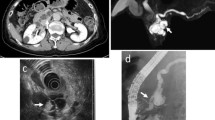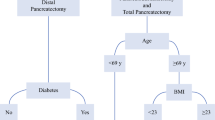Abstract
Background
Routine endoscopic retrograde pancreatography (ERP) for pancreatic juice cytology (PJC) during management of intraductal papillary mucinous neoplasm (IPMN) is not recommended in the international consensus guidelines 2012. The aim of the present study was to investigate the roles of PJC in relation to the new stratification of clinical findings in the consensus guidelines 2012.
Methods
Medical records of 70 consecutive patients who underwent preoperative PJC, subsequent pancreatectomy, and a pathological diagnosis of IPMN were reviewed. Diagnostic ability of PJC to detect malignant lesions was calculated by the stratification of clinical findings.
Results
Forty patients had malignant lesions, including 29 with malignant IPMN, 10 with concomitant pancreatic adenocarcinoma, and one with both. Accuracies of PJC in all 70 patients and in 59 patients with IPMN alone were 77 and 80 %, respectively. The sensitivity and accuracy of PJC in patients with “worrisome features” were 100 and 94 %, respectively. Eight of 11 patients with concomitant pancreatic adenocarcinoma had non-malignant IPMN without risk factors, and 3 significant lesions could be diagnosed only by ERP/PJC. In addition, the management plan based on imaging study changed from observation to resection in two patients who had the single “worrisome feature” of branch duct IPMN and positive PJC results. As a result, PJC altered the management plan in 5 patients.
Conclusions
Pancreatic juice cytology potentially has important roles to determine the adequate treatment choice in patients with IPMNs with “worrisome features,” and to detect significant lesions that could not be detected by other imaging modalities.


Similar content being viewed by others
References
Tanaka M, Chari ST, Adsay V et al (2006) International consensus guidelines for management of intraductal papillary mucinous neoplasms and mucinous cystic neoplasms of the pancreas. Pancreatology 6:17–32
Tanaka M, Fernández-del Castillo C, Adsay V et al (2012) International consensus guidelines 2012 for the management of IPMN and MCN of the pancreas. Pancreatology 12:183–197
Ohno E, Hirooka Y, Itoh A et al (2009) Intraductal papillary mucinous neoplasms of the pancreas: differentiation of malignant and benign tumors by endoscopic ultrasonography findings of mural nodules. Ann Surg 249:628–634
Ohtsuka T, Kono H, Nagayoshi Y et al (2012) An increase in the number of predictive factors augments the likelihood of malignancy in branch duct intraductal papillary mucinous neoplasm of the pancreas. Surgery 151:76–83
Shimizu Y, Yamaue H, Maguchi H et al (2013) Predictors of malignancy in intraductal papillary mucinous neoplasm of the pancreas: analysis of 310 pancreatic resection patients at multiple high-volume centers. Pancreas 42:883–888
Poultsides GA, Reddy S, Cameron JL et al (2010) Histopathologic basis for the favorable survival after resection of intraductal papillary mucinous neoplasm-associated invasive adenocarcinoma of the pancreas. Ann Surg 251:470–476
Furukawa T, Hatori T, Fujita I et al (2011) Prognostic relevance of morphological types of intraductal papillary mucinous neoplasms of the pancreas. Gut 60:509–516
Mino-Kenudson M, Fernández-del Castillo C, Baba Y et al (2011) Prognosis of invasive intraductal papillary mucinous neoplasm depends on histological and precursor epithelial subtypes. Gut 60:1712–1720
Rodriguez JR, Salvia R, Crippa S et al (2007) Branch-duct intraductal papillary mucinous neoplasms: observations in 145 patients who underwent resection. Gastroenterology 133:72–79
Maguchi H, Tanno S, Mizuno N et al (2011) Natural history of branch duct intraductal papillary mucinous neoplasms of the pancreas: a multicenter study in Japan. Pancreas 40:364–370
Ohtsuka T, Kono H, Tanabe R et al (2012) Follow-up study after resection of intraductal papillary mucinous neoplasm of the pancreas; special references to the multifocal lesions and development of ductal carcinoma in the remnant pancreas. Am J Surg 204:44–48
Yamaguchi K, Nakamura M, Shirahane K et al (2005) Pancreatic juice cytology in IPMN of the pancreas. Pancreatology 5:416–421
Yamaguchi T, Shirai Y, Ishihara T et al (2005) Pancreatic juice cytology in the diagnosis of intraductal papillary mucinous neoplasm of the pancreas. Significance of sampling by peroral pancreatoscopy. Cancer 104:2830–2836
Hibi Y, Fukushima N, Tsuchida A et al (2007) Pancreatic juice cytology and subclassification of intraductal papillary mucinous neoplasms of the pancreas. Pancreas 34:197–204
Tanaka M, Yokohata K, Konomi H et al (1997) Segmental balloon cytology for preoperative localization of in situ pancreatic cancer. Gastrointest Endosc 46:447–449
Yamaguchi K, Nakamura K, Yokohata K et al (1997) Pancreatic cyst as a sentinel of in situ carcinoma of the pancreas. Report of two cases. Int J Pancreatol 22:227–231
Ohtsuka T, Ideno N, Aso T et al (2013) Role of endoscopic retrograde pancreatography for early detection of pancreatic ductal adenocarcinoma concomitant with intraductal papillary mucinous neoplasm of the pancreas. J Hepatobiliary Pancreat Sci 20:356–361
Shindo K, Ueda J, Aishima S et al (2013) Small-sized, flat-type invasive branch duct intraductal papillary mucinous neoplasm: a case report. Case Rep Gastroenterol 7:449–454
Adsay V, Kloppel G, Fukushima N et al (2010) Intraductal papillary-mucinous neoplasms of the pancreas. In: Bosman FT, Carneiro F, Hruban RH et al (eds) World Health Organization classification of tumors, pathology and genetics of tumors of the digestive system. IARC Press, Lyon, pp 304–313
Ideno N, Ohtsuka T, Tamura K et al (2013) Intraductal papillary mucinous neoplasms of the pancreas with distinct pancreatic ductal adenocarcinomas are frequently of gastric subtype. Ann Surg 258:141–151
Japan Pancreas Society (2011) Classification of pancreatic carcinoma (3rd english edition). Kanehara Press, Tokyo
Chari ST, Yadav D, Smyrk TC et al (2002) Study of recurrence after surgical resection of intraductal papillary mucinous neoplasm of the pancreas. Gastroenterology 123:1500–1507
Salvia R, Fernández-del Castillo C, Bassi C et al (2004) Main-duct intraductal papillary mucinous neoplasms of the pancreas: clinical predictors of malignancy and long-term survival following resection. Ann Surg 239:678–685
Tamura K, Ohtsuka T, Ideno N et al (2014) Treatment strategy for main-duct intraductal papillary mucinous neoplasms of the pancreas based on the assessment of the recurrences in the remnant pancreas after resection: a retrospective review. Ann Surg 259:360–368
Hirono S, Tani M, Kawai M et al (2012) The carcinoembryonic antigen level in pancreatic juice and mural nodule size are predictors of malignancy of branch duct type intraductal papillary mucinous neoplasms of the pancreas. Ann Surg 255:517–522
Shimamoto T, Tani M, Kawai M et al (2010) MUC1 is a useful molecular marker for malignant intraductal papillary mucinous neoplasms in pancreatic juice obtained from endoscopic retrograde pancreatography. Pancreas 39:879–883
Inoue H, Tsuchida A, Kawasaki Y et al (2001) Preoperative diagnosis of intraductal papillary-mucinous tumors of the pancreas with attention to telomerase activity. Cancer 91:35–41
Uehara H, Nakaizumi A, Ishikawa O et al (2008) Development of ductal carcinoma of the pancreas during follow-up of branch duct intraductal papillary mucinous neoplasm of the pancreas. Gut 57:1561–1565
Tanno S, Nakano Y, Sugiyama Y et al (2010) Incidence of synchronous and metachronous pancreatic carcinoma in 168 patients with branch duct intraductal papillary mucinous neoplasms. Pancreatology 10:173–178
Ingkakul T, Sadakari Y, Ienaga J et al (2010) Predictors of the presence of concomitant invasive ductal carcinoma in intraductal papillary mucinous neoplasm of the pancreas. Ann Surg 251:70–75
Yamaguchi K, Kanemitsu S, Hatori T et al (2011) Pancreatic ductal adenocarcinoma derived from IPMN and pancreatic ductal adenocarcinoma concomitant with IPMN. Pancreas 40:571–580
Kanda M, Knight S, Topazian M et al (2013) Mutant GNAS detected in duodenal collections of secretin-stimulated pancreatic juice indicates the presence or emergence of pancreatic cysts. Gut 62:719–730
Kamata K, Kitano M, Kudo M et al (2014) Value of EUS in early detection of pancreatic ductal adenocarcinomas in patients with intraductal papillary mucinous neoplasms. Endoscopy 46:22–29
Barron MR, Roch AM, Waters JA et al (2014) Does preoperative cross-sectional imaging accurately predict main duct involvement in intraductal papillary mucinous neoplasm? J Gastrointest Surg 18:447–456
Acknowledgments
This study was supported by the Japan Society for the Promotion of Science (JSPS) KAKENHI Grant Number 25298285. The findings were presented during International Surgical Week 2013 in Helsinki, Finland.
Author information
Authors and Affiliations
Corresponding author
Rights and permissions
About this article
Cite this article
Ohtsuka, T., Matsunaga, T., Kimura, H. et al. Role of Pancreatic Juice Cytology in the Preoperative Management of Intraductal Papillary Mucinous Neoplasm of the Pancreas in the Era of International Consensus Guidelines 2012. World J Surg 38, 2994–3001 (2014). https://doi.org/10.1007/s00268-014-2684-y
Published:
Issue Date:
DOI: https://doi.org/10.1007/s00268-014-2684-y




